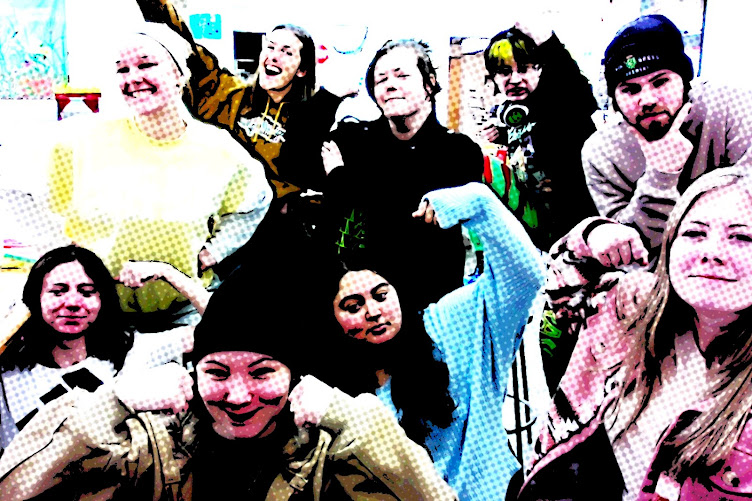KEY POINTS
The teacher utilized art history
for her lessons. She did this by discussing themes, artistic motivations, and
the contextual factors of the time.
Allowing kids to break down the
narrative of the art you have shown will give them the chance to analyze the
artists meaning and construct their own.
By using the remanence of their
inspiration for the Hine lesson, the students were able to deconstruct the idea
of child labor and tyranny. These silhouettes allowed the viewers and the
students to be aware that these issues are still relevant.
In order to interrupted and dissect
something, you have to know what you are looking at. Students must have the
background information on artists, imagery, and social contexts.
Art gives students the chance to
speak. This lets the students the experience of making a statement, editing their
word choices and imagery, and then publicly showing their opinions.
SUMMARY
In Chapter 18, art educator Anne Thulson
focuses on the importance of interruption. She defines interruption as deeply
uncovering, rather than covering the curricula. Her students work on long-term
discovery lessons and she presents three of these in the chapter. The three
lessons she goes on to explain deal with the idea of interrupting the
continuous narrative surrounding power. To do this Thulson utilized art
history. By looking at the themes and motivations surrounding the Dadaist, she
was able to show her students that art can be an outlet for artists to speak on
different subjects and react to different events.
The three narratives that Thulson
explored were 20th century child labor, the Spanish colonialization
of Mesoamerica, and their own school’s culture. By creating an interdisciplinary
curriculum, Thulson was able to secure her students schema and give them the
opportunity to dive deeper into their subject matter. Thulson states that
having an interdisciplinary curriculum allowed her students to critique and
enchant the world. Another key part of Thulson’s lessons is the art history.
Along with working with other disciplines, utilizing art history gives students
the chance to build a better understanding of the art that they are looking at.
By using themes in art history, the students were not bound to chronological
monotony. When students are able to see art history through contextual factors,
such as the Dadaist explained earlier, they can make connections to their own
drive to speak their opinion.
The first lesson discussed was a
Rights of Childhood Collage. This lesson was prompted by the question “does
technology bring us progress?” and analyzing the Futurists of Italy. Through
discussion of the futurists and creation of human-machine hybrids, the students
responded to the question with “maybe so.” With their prior knowledge of the
Futurists, they watch a Charlie Chaplin film Modern Times. His film used humor
to critique how technology has changed society.
With this in their arsenal, Thulson asked her essential question again
and was met with a “maybe not so much.” Now the students were able to
investigate American photographer Lewis Hines. Hines critiqued technology and
industrialization. The students then read the National Child Labor Committee’s
Declaration of Dependence. Students formed an understanding of child labor,
freedom, and the four rights of childhood. After this, the students used all of
their research to create collages inspired by Hine’s photography. They cut the
children out of the workplace and collaged them into one of the four rights of
childhood. Alongside their collage, the students backed their cut photograph
with black paper to make a powerful silhouette.
The second lesson interrupted the
idea of primary sources in history. The area of focus was the Spanish
colonialization of Mesoamerica. Much like the previous lesson, Thulson utilized
history to give her students a better understanding of what they were seeing.
After dissecting Spanish Colonial and Pre-Columbian art, the students were able
to analyze Chagoya’s irony in Codex
Espagliensis. Then the students created their own history collages.
The third lesson focused on the
power of text and images. By using the literature and broadsides of the
Patriots and work of Barbara Kruger, the students were able to see how
important text and imagery can be for voicing one’s opinion. By connecting it
to their school and their lives, students created collaged protest broadsides about
their school.
QUESTIONS FOR YOU TO ANSWER….
- Explain
how the idea of deconstructing rather than simply covering a subject can
lead to a deeper and more meaningful understanding.
- Explain
how art history can change your students work. Think of the pros and cons.
Would they be inspired or bored? Would they just make copies of the work
they saw? Would you test art history?
- Describe
an interdisciplinary lesson you taught or participated in?
Activity:
After being inspired by Thulson’s
use of an interdisciplinary curriculum, I would like you to think of three
different lessons that you could teach alongside another subject. Thulson
correlated her Spanish Colonization Collage with the students’ history class.
What could you do to insure a better understanding of what your students are
learning?

No comments:
Post a Comment